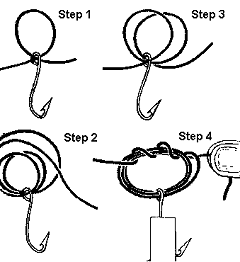Tie Double Clinch Knot
Not All Knots Are Created Equal ; About every fisherperson has their favorite knot. But just how strong is it? Is it compatible with your line? Have you ever lost a fish because of it failing? If not, then you probably will not be that interested in this article. If you do have a break, where does it break, does it have a slight pigtail at the break, or does it just come untied at the eye? Each of these signs of slippage/breakage need to be investigated and understood. Using the same knot and getting the same negative results over and over, blaming it on the line, may actually be your knot.
With so many knots available that you could learn to tie for specific uses, you need to have confidence in your knot and can tie it correctly every time. The weakest link between the fish and you is the knot. So take the time to practice, practice, practice long before you get to your favorite fishing hole.
There are many knots available, some are developed for different types of fishing and may not pertain to other types. If you are not sure what fits your type, ask around. Sure you will get many different answers, but that is a start. There will be some that are the most popular, usually because of the ease of tying, however the important thing is to have a strong knot AND ease of tying is then a bonus. Again, practice before you get on the water will ensure that you will make a strong and secure knot every time. You just never know when you might hook into the trophy of a lifetime! You certainly don't want your knot to fail then. That is why I started tying my own leaders instead of using store bought, mass produced ones that were given me by a "friend" and that I was trying to use them up, where we lost 2 nice Chinook because of knot failure in 2 days at Buoy 10 a number of years ago.
To help understand various knot strengths, I built a KnotBuster. Which is simply a 50# Rapala tube type fish scale (non digital) that records the heaviest breaking weight when the line is wrapped around a small leather drum (1 3/8") attached to a 2 1/2"crank handle. I selected this fish scale, because at the time the digitals were not on the market AND after looking at the digitals later when considering making another unit, there was some concern that the shock of the considerable number of line breakings, this digital scale may not have a longevity as the older mechanical device. Even the mechanical scale had to be rebuilt because the top threaded on cap was originally made of plastic, which soon stripped the threads out that were threaded into the upper tube housing because of the spring bouncing. A new aluminum cap had to be made, that has stood the test of time (many hundreds of knots being tested). The easy part of attaching the scale to the framework was by using 1" rifle scope rings and base mounts. One thing on this scale, it appears that the register pointer moves about 1/2# before it indicates at zero, if that is so, maybe all these numbers are 1/2# light, however the ratio is still the same for all.
In use, about 18" of line is used, and tied to a large barrel swivel. The opposite swivel eye is slid onto the scale's hook with the line then wrapped around the spool and secured around a polished screw head a couple of times to secure it. The single wrap needs to be positioned on the outer edge of the spool so that as the winch spool is cranked down that the line wraps tend to self align itself in the center of the spool, separating themselves as to not allow the line coming from the knot to come in contact with any of the other tension wraps on the spool. During testing, hand tension is maintained on the line's secured tail while using a controlled but even speed on the cranking the handle until something breaks. We try to not reuse the other possible stressed end of the line.
We initially found that a monofilament line of about 20# appeared to be about right as far as allowing for a wider range as being near the center of the scale's range for breakage and ease of tying.
At five of our recent CCA Lewis County fundraiser banquets, this machine was used to add money to our coffers and to find the local fishing knot tying champion. One person did all the testing to maintain continuity. The fee for entering was $5.00 a knot and the prize over the years ranged from a framed fishing photo, a 9' steelhead rod with a Shimano reel and a Frabill Hiber-Net which was a collapsible net that stores inside the handle, and lastly a Berkley digital fishing scale.
The participants could tie any knot they wanted. The prime objective of course was to record the breaking point of the knot, but not a breaking of the line. We also tried to keep track of the style of knot, however some of these contestants would not tell us the knot they were using or possibly did not even know the name of it. For those of us operating this device, we pretty well could tell the knot by just looking at it, or how the person was tying even if they tried to hide the actual act of doing so. The line varied over these years from 20# Stren monofilament (gold color for better visibility), to Danielson white, to Berkley Big Game, to P-Line chartreuse. We finally settled on the P-Line as our line of choice for testing. No hooks were used for safety's sake, but LARGE barrel swivels were the attachment point.
During these sessions, it soon became evident that the 2 top knot strengths was pretty well split between the Palomar and Double Clinch knot with the Uni-knot coming in third. Some broke in the knot while others broke the line about 3/4" in front of the swivel eye. The real difference appeared to be the method of actual tying (more likely the final pull tight on a dry line). By this, it seemed that when the line broke, it was probably because the tier did not lubricate the line/knot well prior pulling it tight and friction roughed the line, weakening it. Even Copenhagen juice was tried, but did not seem to make much of a significant difference. One even contestant brought his own Vaseline lubricant.
There were about 40 entrants one year with the breaking point of the knots in this experiment ranged from 15# to 23.3#, with the bulk of the breakings being between 18# and 21# for the Stern line. We considered that this was probably about right, in that the line weight was 20#. When the line actually broke because of fraying, it was closer to 17#. The Danielson line was limper and required a closer inspection by the tier just before the final tightening process to ensure that a tight loop was not pulled under the wraps and we discontinued it because of the impression of us using a CHEAP inferior line. The P-Line we used being a little stiffer performed well, however right off the spool, it seemed to be considerable slipperier, requiring the tail of the knot to be pulled tighter and/or left a bit longer. The highest tested knot using the P-line was 29# with other high numbers 27#, 27.5# and a tie at 24.5#, while most were in the 18-21# range. It seemed to have a more consistent and higher breaking point.
We found that some lines would break before the knot did and under these conditions we did not want the tier to be in a situation where they paid only to have the line break. So by trying different makes of lines before the event, we found a couple that it always broke in the knot. This solved that problem. When using the medium to stiffer lines if the knot was good for that line, it was prone to have the line occasionally break before the knot did. These being the common higher grade lines, like Maxima, Shakespeare, Ande etc. We had to find a line that the knot itself would break otherwise we had participants who demanded (and justifiably so) a second or even third FREE try. The one line we found that would continually break IN the knot was Danielson, which is a very limp line. The suspicion was that since it was so limp, that if the participant was not really observant when doing the final pull tight effort, there may have been a tight loop that did not get straightened out but then unknowingly resulted in a kink being pulled into and under some of the wraps of the knot.
However we encountered some fishermen who looked down on the cheaper Danielson line, especially if THEIR knot broke at a lower number than the winner, so the following year we moved to the P-Line CXX, which was somewhat stiffer, however it is a lot slipperier, but we got no more negative questioning even from the losers.
| Here our Knotmeister is checking out the strength of a knot |
| |
For those of you who have never tried to give your knot a test, if you get the chance, this can be a very educational learning experience. There is a difference in tying a knot to a swivel as compared to a hook, so if possible, try both. However protect yourself, or utilize some sort of cover over the hook as it will usually go flying at the line/knot break.
If you do not have access to a machine like this, you can devise a tester by using a Berkley digital scale, and use an empty soup or soda can, cut the lid out and tie it to something solid. Keep adding sinker weights, until the knot, or line breaks.
In much testing, one of our PSA members has discovered that many small things may contribute to a better knot. (1) When tying a Palomar knot to a hook, do not pull the loop onto the eye of the hook, but on the line in front of the hook, which increases the knot strength considerably. He even leaves a tad bit of space between the loops and the eye, that may tighten down when a fish is on, as he believes the knot strength here is even greater. (2) When tying a egg looped knot, make your initial wraps at LEAST 12 wraps before you loop it back to make the egg loop, using another 5 or 6 wraps. This does 2 things, provides more room for the egg cluster, but more importantly increases the knot strength as when he only tied 6 or even 8 wraps the knot would break at the area where the secondary loop wraps started. Maybe it would be stronger when it had an egg sac under the loop? His thoughts were possibly with more wraps this did not let the rear wraps slip forward.?? One very successful guide has said his egg loop leaders are tied using 15 wraps. I tie 16 wraps just because I don't like uneven numbers.
When tying leaders using a Snell Knot onto a hook or with other conventional methods, the strongest way to tie the leader onto the hook is to wrap it so that when holding the hook in your left hand, and do a clockwise wrap going around the shank first ON MOST HOOKS. What is important is to make your wrap around the side that the hook's shank is attached to, NOT the side where the end of the eye is. This places the leader around the solid part (shank) of the eye, and not laying on the cut end of the eye that is against the shank. With GOOD hooks it may make no difference, but if you get a hook that this eye is not formed well at the cut off, many times if you get a lost fish due to a cut leader at the hook's eye, you will find that the leader was pulled into this sharp cut off end of the eye loop and all you will have a small pig tail at the cut end of the line.
Learn to tie a double or even triple hook mooching leader as at times you will want a cut plug a herring and to only have the front hook in the bait, with the back hook trailing, with this you then need to tie your leader hook distances appropriately.
For those of you who are interested, purchase the paperback book "Tying Strong Knots" by Bill Herzog. Or on the internet, Google "fishing knots" where most of the illustrations below came from.
Listed below are some common fishing knots using conventional methods and a brief instructions in tying them.
Common Fishing Knots
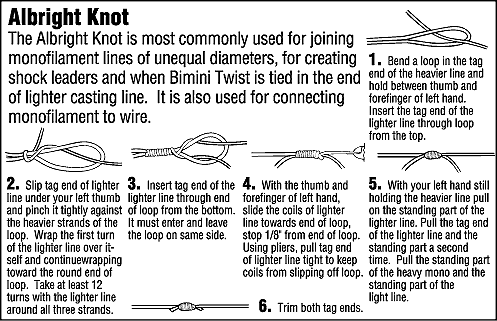 | 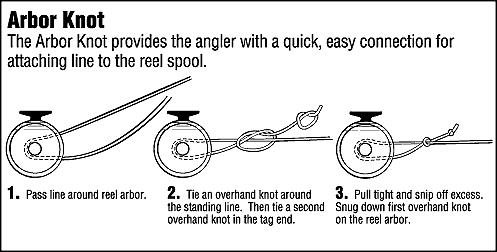 |
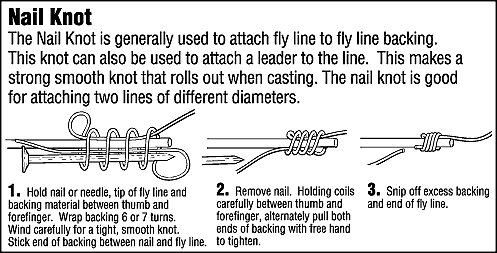 | 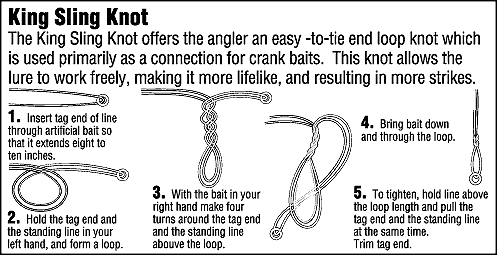 |
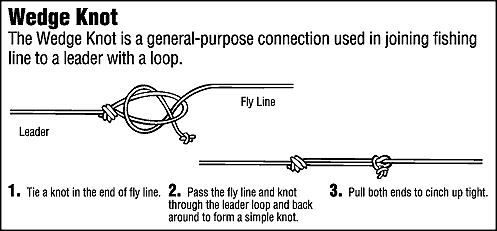 |  |
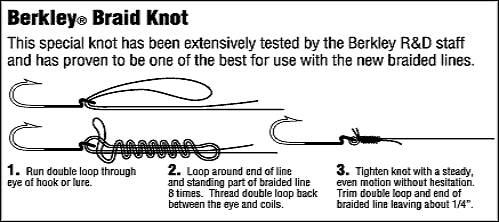 | 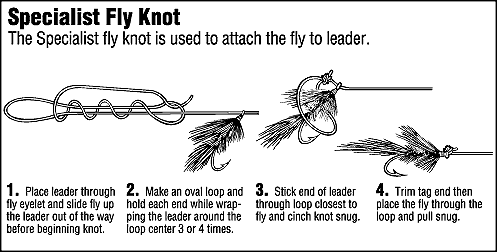 |
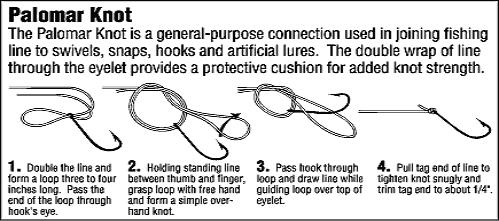 | 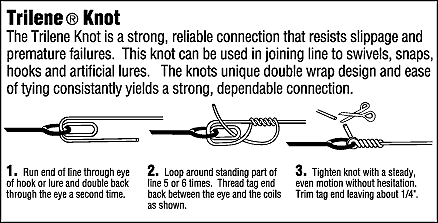 |
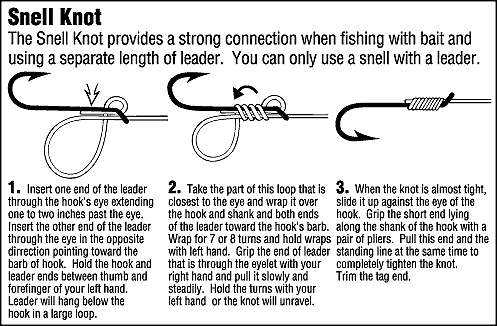 | Uni- Knot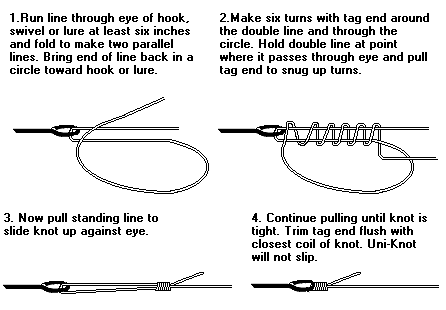 |
| Clinch Knot 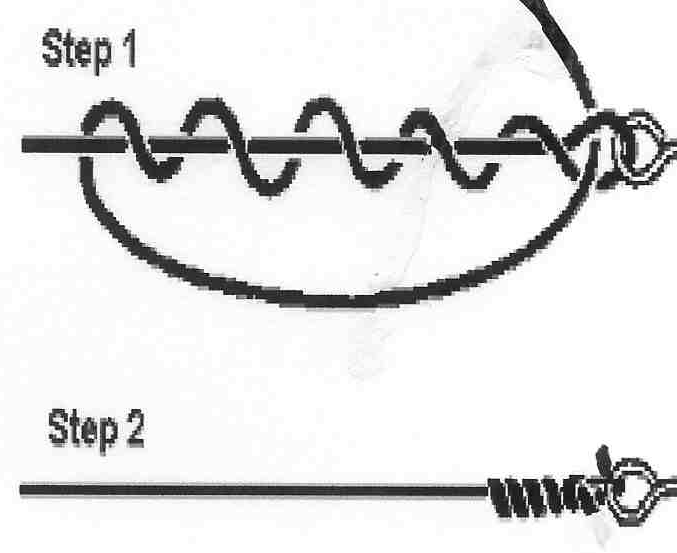 1. Pass the line through the eye of the hook, or swivel. 2. Double back. make five turns around the line. 3. Pass the end of the line through the first loop, above the eye. Draw the knot into shape. 4. Slide the coils down tight against the eye. | Improved Clinch Knot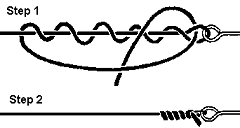 1. Pass the line through the eye of the hook, or swivel. 2. Double back. make five turns around the line. 3. Pass the end of the line through the first loop, above the eye, and then through the large loop. Draw the knot into shape. 4. Slide the coils down tight against the eye. |
| Jansik Special Another somewhat simple knot that can be tied in the dark and has a high strength 1. Put 15cm of line through the eye of the | Float Stop or Bobber Stop Float fisherman use a sliding float for casting and yet being able to adjust it's dept. This knot stops the float from sliding up the line. The advantage that the stops can move readily through the rod guides, but grips the monofilament nylon so tightly that the float will not slide up the line. It should be made of Dacron, usually the same diameter as the line itself. 1. Take 2 or 3 turns around the main line |
Dropper Loop 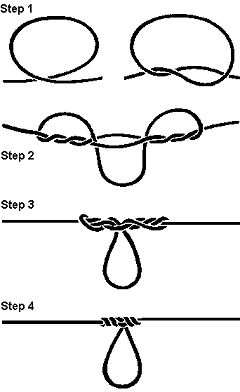 A good method of forming a loop in the line above the sinker. This knot stands out at right angles to the line. 1. Form a loop in the line. 2. Take hold of one side of the loop, then make 6 or more turns around the line itself. 3. This is the tricky part - keep open the point where the twists, are being made. 4. Take hold of the other side of the loop, and pull it through the center opening. Use a finger in this loop so that it is not lost. 5. Hold this loop between the teeth. Pull gently on both ends of the line, making the turns gather on either side of the loop. 6. Draw up the knot by pulling the lines as tightly as possible. The turns will make the loop stand at right angles to the line. | Improved San Diego Knot 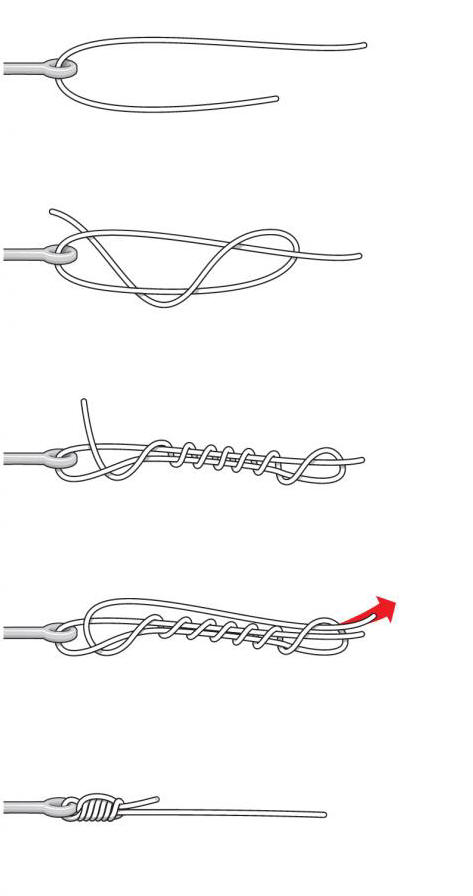 A good, yet simple and easy knot to tie 1 . Run the line through the eye2. Pull it out, make a loop. Pinch this loop 3. Make at least 5 wraps over both the mainline and loop. Tuck the tail in between the loop at the eye 4. Pull the tail forward and tuck it under the front loop that you are pinching 5. Wet the complete loose knot. Pull the mainline tight, while maintaining tension on the tail by holding with your teeth The Basic San Diego Knot only uses one tuck at the upper loop. |
| Egg Loop Knot |
Shown below, Fisherman's knot is similar to a Clinch knot, however is stronger because the wrap is OVER both strands. It is an offshoot of the San Diego knot but wrapped from the front. It is easier to tie as the as you start the warps at the lure eye and wrap forward, then tuck the tail into the forward loop. It is only slightly weaker than the San Diego knot. And I have found that sometimes when you do a double tail tuck, (like on some of the IMPROVED versions) that this 2nd tuck induces the chance of the line being cut at the first tuck when the line is under stress because the 2nd tuck locks the tail and does not allow any chance of self tightening of the whole knot.
| Here is about the most simple terminal knot, simply called the Fishermans Knot |
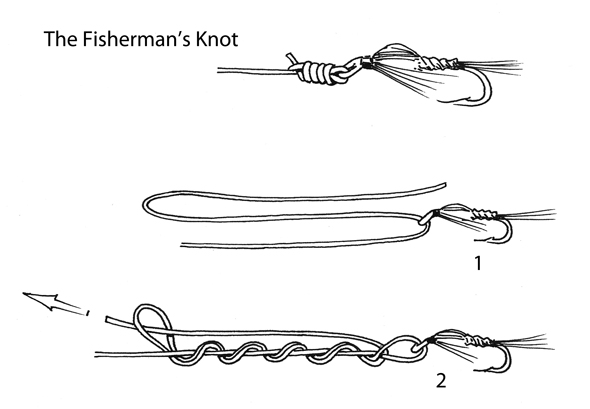 |
Shown below is a simple knot to connect Mono to Braid line, is the smallest, compact knot out there, and was developed by a California long range charter Captain by the name of John Collins.
There are a couple of simple secrets in effectively tying this knot that can not be effectively described without seeing it done, so CLICK HERE to a video link .
| Here is a simple John Collins knot designed to connect Braid to Mono |
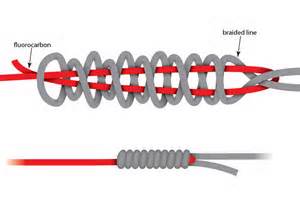 |
After the second of our CCA banquet fundraiser events, my curiosity was aroused and I started my own testing with the results shown below, it became obvious that stiffness of the mono seemed to have an outcome on the knot breakage. Stiffer lines (to a degree) seemed to allow for better even wraps, which then seemed to do better because of non overlapping/or pinching conditions. I tried to perform a stiffness test by allowing 6" of this line to protrude from my fingers, and then see just how much gravity drop each had. This proved fruitless in that line right off the spool had a memory situation. I finally just arranged these test lines in my own visual observation, with the possible stiffer lines being on the left of the chart below.
| Knot | 20# Stren High Impact | 20# P-Line CXX | 20# Berkley Trilene Big Game | 20# Ande Premium | 20# Shakespeare Outcast | 20# Maxima Ultrgreen | 20# Danielson Premium plus 7 |
| .0180 Dia. | .0180 Dia. | .0180 Dia. | .0177 Dia. | .0184 Dia. | .0183 Dia. | .0184 Dia. | |
| Clinch Knot | slips, will not stay tied | 12.6 - 13.3 | slips, will not stay tied | 14.3 - 16.2 | slips, will not stay tied | slips, will not stay tied | 12.1 -13.3 |
| Improved Clinch | 19.3 - 20.0 | 15.5 - 18.5 | 13.8 - 15.2 | 14.9 - 21.2 | 12.1 - 17.1 | 14.2 - 15.7 | 15.2 - 17.5 |
| Basic San Diego | 17.5 - 20.5 | 17.3 - 19.5 | 15.1 - 17.2 | 16.4 - 17.3 | 16.6 - 18.4 | 15.5 - 15.7 | 11.5 - 14.1 |
| Imp. San Diego | 25.0 - 26.5 | 26.2 - 26.3 | 20.9 - 22.9 | 19.1 - 21.5 | 16.2 - 20.1 | 18.1 - 20.6 | 13.3 - 19.0 |
| Fisherman's Knot | 19.0 - 21.2 | 19.5 - 24.4 | 16.0 - 18.0 | 18.4 - 20.5 | 15.1 - 16.2 | 15.4 - 16.1 | 14.3 - 18.5 |
| Uni-Knot | 19.4 - 26.0 | 18.8 - 22.3 | 18.4 - 19.2 | 20.6 - 22.3 | 16.5 - 17.9 | 16.3 - 18.3 | 13.0 - 17.4 |
| Trilene Knot | 16.6 - 17.1 | 17.3 - 24.2 | 16.4 - 17.9 | 17.3 - 21.2 | 14.3 - 17.5 | 15.8 - 16.6 | 12.1 - 17.2 |
| Palomar Knot | 17.8 - 18.8 | 21.2 - 23.5 | 16.4 - 20.8 | 20.6 - 22.3 | 17.5 - 19.5 | 15.5 - 19.2 | 17.1 - 17.8 |
| Jansik Special | 23.6 - 24.5 | 24.2 - 27.2 * | 14.4 - 17.5 | 16.2 - 17.3 | 14.5 - 16.5 | 14.5 - 18.0 | 15.3 - 16.2 |
| Berkley Braid | 21.8 - 24.5 | 12.5 - 12.6 | 20.8# | slips, will not stay tied | 11.2 - 14.0 | untied at 11# | 14.8 - 15.6 |
| Snell Knot | 21.1 - 24.6 | 21.5 - 23.1 | 16.2 - 21.7 | 20.2 - 21.5 | 16.2 - 19.8 | 17.3 - 18.3 | 14.2 - 19.1 |
| Egg Loop Knot | 20.7 - 23.2 | 26.3 - 27.5 | 20.3 - 20.8 | 21.3 - 22.5 | 19.9 - 22.1 | 18.1 - 19.0 | 16.5 - 19.5 |
| Slider Mooching | 16.0 - 17.8 | These were discontinued for a safety i ssue of not being able to retain/contain the hooks at the break, but do give a representative number | |||||
During the above tests, 20 pound test monofilament lines were used throughout (except the Berkley Trilene where 25# was used, but was reduced by 20% for the numbers seen here). Some lines were new off the shelf, while others were older, but never on a reel or exposed to heat or sunlight. No special inspection of any knot was done (except the Snell knots as explained below), simple tying, tightening and then tested. This non inspection probably accounts for a few wide ranges of knot breakage of some styles of knots, but I was trying to duplicate a on the water/stream bank situation. All single looped knots were wrapped using 5 wraps, double looped knots used 3 wraps. All knots were lubricated using saliva. No pliers were used to pull the tail, just a extra length as a tag pulled by hand or tightened by pulling with your teeth. A minimum of 3 knots were tied for each test. The numbers shown above were just what was recorded and not averaged out. Low breakages were NOT discounted.
For tying leaders to hooks, most fishermen use a larger size line (many times 5# to 10# more) to compensate for abrasion or possible teeth nicks.
The Snell Knot was tied using 10 wraps on a 3/0 Mustad Octopus hook. These knots were somewhat of a surprise, but it seems by the nature of the knot, on the final pull, IF YOU DO NOT initially have the leader AND the tail parallel, you can easily get one line laying across the other, which can ultimately cut one of them. When poking the leader back through forward at the start, just before the wrapping of the tie, the tail needs to be on the opposite side of the loop, which is laying along the hook shank when you start your 1st wrap. When finished, the leader exiting the hook's eye needs to be on TOP of the 1st wrap.
Also for the Snell and Egg Loop knots, when pulling the wraps, stop just before the final snug up and check the last loop for a possible kink. If you stop the pull just right, you can pick this kink back with your fingernail, which will allow it to then straighten out, otherwise you will have a twist under the other loops that you will never see, which can create a weak spot.
The Egg Loop Knot was wrapped 16 with initial wraps, then 6 to 9 more to produce the loop's knot. Initially in testing, this loop knot wraps were only 6, but slippage was experienced, creating friction and breakage. These knots appeared stronger and more consistent than the Snell knot, probably because of no overlaying at the eye. However when they broke it was at the juncture of the 2 wraps where the loop came out. It appears for these, that they need to be pulled FAIRLY TIGHT for the final tying.
The Slider Mooching tie consisted of using a standard Snell tie on the bottom, then a slider for the top hook. The slider tie was simply using a egg loop tie over the main leader. The low breaking number shown above was as normally tied. The higher number shown was achieved by adding a 4mm plastic bead between the two hooks as a buffer. This knot was included in this just as a "What If" question arose as it's breaking point will actually depend on the lower knot.
Another knot that I tried, was the standard old overhand (sometimes called the Granny) knot. This can be used at the end of leaders that attaches to an attractor. Here, leader length many times depends on the type of attractor used. Most fishermen tie these leaders long and simply cut to length and tie a loop knot in the upper end instead of having to tie it direct all the time. The standard overhand knot is not very desirable, BUT if you do the second loop through the eye, when pulled tight, it is quite efficient. In testing this, using the 20# P-Line, my breaking test was at 19#, which I was quite impressed at. All of my attractors/ lines/extension, have a snap on the bottom end. This helps immensely if lines get tangled. I used to tie in a swivel on all upper ends of leaders for the snap to attach to, but this new knot (to me) does the same and eliminates that swivel as a connector on some leaders that I may have to adjust the length on.
Observations/Conclusions ; This test revealed many long standing commonly perceived "good line/bad line" misconceptions. Common sense dictates that it hard to really compare knots alone, as line characteristics are thoroughly involved in this mix also. That is what this test set out to accomplish.
Some fishermen do not rely on advertised line weight, but by line diameter. Apparently some manufacturers over rate while others under rate their lines as far as weight goes. Others, if they do list the diameter on the spool, it may not be exactly true, and if so, will always be smaller than actual, because they somehow want to relate line size to being smaller for less visibility or water resistance, putting out the impression that their line is better. How do you know without doing your own measuring or line breaking tests? For those of you who want to take a look at comprehensive line tests by Vince Hawkins for Gamefishin.com CLICK HERE. From my way of looking at this, since each manufacturer has different specifications as for hardness/limpness which may have been established for lines to be used under different conditions, line diameter may not be significantly linked directly to actual knot breaking strength.
My line of thinking is, that the line breaking strength means nothing, if the line's characteristics does not allow it to tie strong knots.
Another thing that you need to be aware of is that some manufacturers have different grades, or versions of lines, like Maxima's Chameleon, Ultragreen or High Visibility, all different versions of the same manufacturer of mono lines. And then names used on lines may not really mean the same to you as it did to someone employed by the manufacturer's advertising department at the time they tacked on a catchy fraise name. So unless you have done a lot of looking, feeling, tying, you may be like many of us who simply buy what your partner recommended or your uncle has used for years. Do not get caught off-guard if your friend says he uses XYZ line but does not give you the version of it. When you go to buy a line the same as his, you may get a lesser grade than he was using. And some sporting goods stores may not carry all the versions of each brand, just what their buyers order, they inventory and sell. Just because one brand sells well off the dealers shelves, does not mean it may be the best for your application. Also with the newer high visibility lines now being commonly used, some manufacturers may not offer them in the same characteristics as a different but desirable line.
Knot breaking strength will include many other things other than actual line breaking strength. This being the case, one knot may be right for a specific line, but appears totally unsuited for another brand/composition of line. Also some knots appear to be better suited for tying lighter/heavier line weights than others, with 20# seemingly being near the dividing point. It was noticed on some real limp lines, (especially when tying Snelled hook leaders) at the point where the wraps are laying in for their final placement, just before final pull tight, the last loop may form a twisted short loop, and if not straightened before the final pull, will become pulled under the other wraps, creating a weak spot where this twist WAS, which is now UNDER the other wraps that you can not see. This limp line requires close visual observation, especially at the pre-final and final operation of pulling it tight.
Some knots seem to require pliers to tighten the knot's final tail pull, (like the Clinch Knot or the Berkley Braid Knot) while others performed better with NO (or little) pressure on tail at all, therefore just because someone recommends a particular knot, they may have developed other specific minor requirements involved that effect the quality of the finished knot that you were not privy to.
It became apparent during these tests, that on most knots, when the knot is on the final tightening, that the tail may be held by the tier's teeth, but ONLY to maintain a slight amount of tension, keeping the wraps in place, NOT to pull the tail tight until the knot is mostly complete, but just to keep the slack out. Any pulling the tail tight needs to be done AFTER the knot is 95% sucked down, then pull the tail to eliminate any looseness in the final knot. Then possibly another pull on the main line to suck everything in. If the tail is pulled tight at the same time the knot is being finalized, this pulling of the tail section COULD disrupt the laying of the wraps, which can then create a weak/tension spot which could lead to premature breakage. BUT further testing found that just pulling by the tier's teeth was sufficient, as if the tail was at the final pull was pulled using pliers, that you ran a very good chance of weakening or partial cutting a strand or two of a under wrapping.
After this test was tabulated, there appeared to be inconsistencies for certain brands/knots. These were looked at and one knot of each was tied as a qualifier. If that breaking point fell within the tabulated numbers, no change was made. Only one line breaking weight was changed (it being a rather high number and totally out of the range) which resulted in discarding all that data and retying three more knots.
From this experiment, it is pretty obvious that if you find one knot that performs well on YOUR favorite line, it MAY not be that good for another brand. This is shown in the above test results for the Jansik Special Knot when you compare the P-Line knot breakage to any of the other line breakage using this same knot.
Some of the stronger more complicated/stronger knots were a Pain In The A$$ to tie, and probably not worthwhile to consider for the average on the water fisherman. Therefore a simple easy to tie, consistent, but with possibly a slightly lesser strength knot, seems more practical most of the time. Also in the mix, I considered it important to not having to inspect each knot for proper (exact) lay of the wraps, as many of us older fisherpersons wear bi/tri-focal glasses, and sometimes close-up things become a bit fuzzy if we get fog or water on them, therefore an as wrapped/tied knot would be a more desirable. In that mix is also the fact that many of us old fogies may even have a finger or two deformed or even parts of them missing from accidents from our working life around machinery. Therefore, simplicity again soon becomes a necessity.
Some lines were limp and slippery enough right off of the spool to where a simple knot where the tail was NOT tucked a second time, like the Clinch Knot, (even after pulling tight with a pliers this knot would not stay tied part of the time), however if the line tail was additionally tucked into the front loop like the Improved Clinch Knot, it would then stay tied and hold good. These same lines, after being used a while and having been in the water, seemed to have this problem disappear.
One knot that was tried, but proved hard to tie was eliminated from this test, it being the Double Improved Clinch Knot. It was hard to do an easy tie with mono of this size or larger, resulting in inconsistent good ties and/or showing very erratic results as to the breaking points of the knot, probably because with so many wraps, if some did not lay exactly right, they could cut each other. Another knot that I started out with, but dropped because it was so close to other existing more well known knots was the "Eye Crosser".
The Berkley Braid knot when used on mono surprised me but it either breaks at a low weight, or even though you pull the "pull through loop" as tight as possible, some slippery lines do not hold the knot enough and it just slips loose. However it did better on the stiffer lines. Just to let you know, it is a bitch to tie with mono.
One thing I found was a occasional considerably high breakage weight number, but these were all traced to line breakage, and not at the knot. These were disregarded and redone. Upon inspection I found that wrapping the tail of the knotted line around the leather padded winch spool, that IF the line coming from the knot came close enough to the other spooled tension wraps, the two could interact even slightly and the line would break at that point. The thought here was then that if the knot itself broke, it would be more sudden and the weight register indicator would stay where it was, but if the line got abraded, it would be stretched slightly (usually about an additional 3 or 4#) before the actual break, where the scale weight indicator would then be reading a higher reading because the distance was more.
Of the knots tested here, t he easiest consistent higher strength knot to tie appears to be the Improved San Diego Knot. Then for a second consistent knot, a flip of the coin between the Palomar or the Improved Clinch knot. The San Diego Knot style knots do not have to be conventionally wrapped, but the hook/swivel eye can just be rolled, twisting the line and producing the wraps, which can be helpful if you have cold, wet fingers. Listed here you will find a name that I tacked onto a knot because fits into a sequence of tying that expands into other knots, my Basic San Diego Knot is basically the Improved San Diego Knot but ONLY utilizes the tail tuck at the front loop.
The knot I had known and used it for over 60 years was the Fisherman's Knot, however it goes by other names also, like the Pitzen Knot, or the Eugene Bend knot plus another name or two. This one is very similar to the San Diego Knot. One thing when tying this knot be sure you make the single tuck going through from the open side loop and not come in from the back, otherwise you may weaken the knot where it will put tension on, cutting the line upon full tightness. I have found only 6 wraps are sufficient on this knot. In out CCA banquet testing, MANY of the older fishermen seem to be using this knot also.
While we are on knots, when you need to connect braid to mono, one of the best and easiest is to use a double Uni Knot, (one on each line) but double the braid at the knot location. The doubled braid helps make it "stickier" and less likely to cut into the mono. To clarify this, the doubled over braided line created by your loop AS a single strand and then tie your double Uni Knot as you normally would on each end. The other good knot for this is the Slim Beauty, which uses somewhat of the same principle of doubling the braid.
NOTES * This is a very strong knot, and holds quite well, however during our tests, this line broke 50% of the time from 26.7# to 27.7#, mind you using a 20# line.
Improvement ; We found that the 20# line weight and the mechanical advantage of the Knotbuster's design/length of the crank handle would be hard to use a much higher line weight. This leverage situation proved a disadvantage if a knot was good enough requiring the handle to be rotated beyond 270 degrees, as leverage was changed when going from the down stroke into an upstroke, which could effect the rhythm of the movement and possibly change the breaking point. At this point we have went to a 15# line, hoping to have the knot break before the handle got to the bottom of the stroke. We found that by using a bright colored line, we left less short ends laying around, as the brighter color made it more seeable if on the floor.
After seeing the somewhat wide range of breakages during the last CCA banquet usage of the Knotbuster, even though the knotmaster tried hard to be consistent, it appeared the problem was in the design of the knotbuster itself. I did a 2AM engineering redesign and then the next day made a slight modification to it. First I bandsanded the roughed up leather spool for a smoother surface, removing a few grooves that had evolved after a few years of usage.
I then used the existing buried set screw that holds the aluminum spool to the shaft and replaced it with a oval headed countersunk stainless steel screw, with the depth of the screw being ground down so that the taper under the head was tight against the leather spool when the screw is bottomed out against the shaft, to help eliminate any possible cutting of the line occurs.
Now in use, wrap the line down on the inside, around the spool, up on the outside and take 2 or 3 wraps around the screw head with the tail of the line. This relieves the operator of the problem of trying to maintaining a lot of constant tension on the line, (but now just enough to keep it from unwinding off the retainer screw). This screw being far to the left also accomplishes the needed line �Climb� toward the center eliminating overlap and abrading the line in case two loops got to close together on the final downward pull. Also, I set the crank handle so it is now pointing toward the operator when the new anchor screw is UP (as seen in the photo below). This gives the operator more control of cranking forward and down in one motion for the break, instead of the possible line slipping where the operator could then doing the final breaking rotation if on the an awkward upward stroke. Also noticed is if the operator does not make the crank in one smooth operation (like hesitating on the backstroke) that it can give a variance (possibly stretching the line slightly) before the actual breaking of the line.
It also allows for a shorter line needed being used so the operator does not have to really maintain grip on those short ties where the tier wasted a lot of line making the knot.
So
Just part of the learning/perfecting process on behalf of the design engineer. Patent improvement 985225416XX
In use, about 18" of line is used, and tied to a large barrel swivel. The opposite swivel eye is slid onto the scale's hook with the line then wrapped around the spool and secured around a polished screw head a couple of times to secure it. The single wrap needs to be positioned on the outer edge of the spool so that as the winch spool is cranked down that the line wraps tend to self align itself in the center of the spool, separating themselves as to not allow the line coming from the knot to come in contact with any of the other tension wraps on the spool. During testing, hand tension is maintained on the line's secured tail while using a controlled but even speed on the cranking the handle until something breaks.
Copyright � 2011 - 2020 LeeRoy Wisner All Rights Reserved, however some of the knot illustrations are internet copied. Back to the Main Ramblings Page Originated 04-03-2011 Last updated 11-17-2020
Source: https://www.leeroysramblings.com/strong_knots.htm
